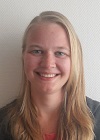
University of Utrecht, the Netherlands
Cyntha van den Berg is a PhD student in Cell Biology at the University of Utrecht, the Netherlands. She visited the EMBL Imaging Centre twice in 2022 to perform image acquisition at our MINFLUX.
Her project focuses on CSPP1, a ciliary tip protein that stabilises microtubules of centrioles and ciliary axonemes. This protein contains a complex array of short microtubule-binding domains. The aims of Cyntha’s project were to explore whether these domains bind to the microtubule lumen or to the other surface and to identify the minimal microtubule lumen-binding domain.
What was the specific scientific challenge that you could overcome thanks to our service?
Thanks to the use of MINFLUX, we could obtain data on the localization of the full-length CSPP1, as well as its fragments. Before the development of the MINFLUX technology, it was not possible to determine whether the protein localises on the inside or outside of microtubules, least of all individual protein domains.
Which imaging technologies in the EMBL Imaging Centre did you apply?
With the support of Sebastian Schnorrenberg, we have applied MINFLUX nanoscopy.
Which new technique/sample preparation did you learn at the EMBL Imaging Centre and will you be able to apply it in the further course of your studies?
Together with the Sebastian, we developed a new sample preparation method for MINFLUX imaging of in vitro reconstituted microtubules. This method can be used to continue studying microtubule proteins with MINFLUX nanoscopy.
What results did you achieve using our services and could you publish those?
We obtained data showing that the full-length CSPP1 protein and its fragments localise in the microtubule lumen. The results are available on Journal of Cell Biology doi: 10.1083/jcb.202208062.
How long did you stay with us and how did you like staying on site/in Heidelberg?
I stayed for two visits, each of 6 days, sponsored by the Christian Boulin fellowship. I stayed at a hotel close to the centre of Heidelberg and I really liked it. The city was nice and the transport to EMBL was easy.
Anything else you would like the future users of EMBL Imaging Centre to know?
I really appreciated the time and help of the Imaging Centre team. They really support you where they can and are very involved in your project.